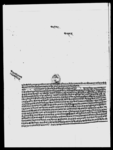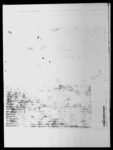A lālamohara from King Rājendra updating a VS 1863 land grant to Raṅganātha Pauḍyāla (VS 1890)
ID: DNA_0013_0077
Edited and
translated by Simon Cubelic
in collaboration with
Rajan Khatiwoda, Ramhari Timalsina
Created: ;
Last modified: 2017-07-06
For the metadata of the document, click here
The accompanying edition, translation/synopsis and/or commentary are available under the terms of the Creative Commons Attribution-ShareAlike 4.0 International License
Abstract
This lālamohara issued by King Rājendra records the land granted to Rājaguru Raṅganātha Pauḍyāla as kuśabirtā-bitalapa by the king’s father as remuneration for his Purāṇa recitation during Caturmāsa in 1806.Diplomatic edition
[1r]
श्रीदूर्गाज्यूः\1श्रीगुरुपंडितराजश्री2रंगनाथपंडितज्यू•१श्री५वुवाज्यू२[royal seal]1स्वस्तिश्रीगिरिराजचक्रचूडामणिनरनारायणेत्यादिविविधविरूदावलीविराजमानमानोन्नतश्रीमन्महाराजाधिराजश्रीश्री
2श्रीमहाराजराजेन्द्रविक्रमसाहवहादूरसम्सेरजङ्गदेवानांसदासमरविजयीनाम् ¯ ¯ ¯ ¯ ¯ ¯ ¯ ¯ ¯ ¯ ¯ ¯ ¯
3आगे ¯ ¯ ¯ ¯१ ¯ ¯ ¯ ¯लाईसम्वत्१८६३सालमितिकार्तिकशुदि१२रोज७कादिन ¯ ¯ ¯ ¯२ ¯ ¯ ¯ ¯कावाहुलिवाटचतुरमासाकापुरा
4णकोदक्षिणाकुसविर्तावितलपसंकल्पगरिवक्स्याकाषेत९।•मध्येथानसिंकाअम्वलभैरवकुंडषेत४।•सयमुर्याषेत१।•
5कुषुर्याआँध्याषेतमुरि।३६मकैचौरघड्यारिरोपनि६३वडेगाउकाषेत४।कोरोपनि२८ज्मारोपनि९१र•षेतमुरि।६४
6कोसाटोवनवनेलोभिरभाव़रज्माषेत६।घड्यारिपाषासमेत्कोसाँध•पूर्वरैकरषेत•भडारिव्राह्मणकोपाषो•षो
7ल्सि•ठुलोढुंगो•तेर्छोवाटोपानिढलोपहरोभनज्याङ्लुहूकिल्•दषिन•मुलवाटोलुहुकिल्•पश्चिम•वरभन्ज्याङ्भगी
8रथव्रह्मचारिर•श्रीकृश्ण अधिकारिकाविर्ताकोषोल्सिज्योगिषोलाकोदोभन्रैकरषेतलुहुकिल्•उत्तर•रैकरषेत
9भडारिव्राह्मणकोजफ्तिविर्तालुहुकिल्•येतिसिमानाकाचारलुंहुकिल्भित्रकाजगाकोसर्वकर अकरसर्वाङ्कमा
10रिमेटिमोहरताम्वापत्रगरिवक्स्यौंआफ्नाषातिरजामासँगविर्त्तावितलपजानिसन्तानदरसन्तानपर्यंतसुषभोग्यग
11रनुहव़स्•हामिलाईआसिरवादवक्सदैरहनुहव़स्•योविर्तावक्सदासंकल्पवाक्यपह्र्न्यायदुनाथपुरोहित•पा
12निहालन्याश्रीजनरलभिमसेनथापा•साधलाउन्याथरघर•कासिरामपाडेश्रीनाथपंथ•भवानिसंकर अर्ज्याल्•भानु
13पाध्याषनाल्•वंसविरराना•हरिवंसवोहोरा•भास्करपाध्या•दुवैकृष्णानन्दपाध्यारिमाल्डगोलधनवन्तनाय
14क्जगतसिंजु•थानसिंकाभलामानिस्•द्वार्यासर्मानन्द अधीकारि•थरिपूर्णानन्दभडारि•विरभद्रभडारी•श्रीकृश्ण
15अधिकारि•रामकृष्ण अचार्ज•रामचन्द्रवासवोटा•धर्मानन्दधिताल्•रामचन्द्रनेव़पान्याकालुरिमाल्•रंजीतरुचाल्सर्व
16जितवस्न्यात्देवनारान्धिताल्•दामुधिताल्•वासुदेवषतृकालुषत्रि•चामुभडारि•भिमसिन•भिमराईमाधौ
17दनुव़ार•चाम्यानेव़ार•स्वदत्तांपरदत्ताम्वायोहरेच्चवसुन्धराम्•षष्ठिवर्षसहश्राणिविष्ठायांजायतेक्रिमिःइति
18सम्वत्१८९०सालमितिश्रावणवदि२रोज४शुभम् ¯ ¯ ¯ ¯ ¯ ¯ ¯ ¯ ¯ ¯ ¯ ¯ ¯ ¯ ¯ ¯ ¯ ¯ ¯ ¯ ¯ ¯ ¯
[1v]
मार्फतरणजोरथापाTranslation
[1r]
Venerable Durgājyū
Venerable Gurupaṇḍitarāja, the Venerable Raṅganātha Paṇḍitajyū 11
Fivefold Venerable King Father 22
Hail! [A decree] of him who is shining with manifold rows of eulogy [such as] ‘The venerable crest-jewel of the multitude of mountain kings’ and Naranārāyaṇa etc., high in honour, the venerable supreme king of great kings, the thrice venerable great king, Rājendra Vikrama Śāha, the brave swordsman, the divine king always triumphant in war.
Among the 9| khetas [of land] that were granted by ritual declaration (saṃkalpa) as a kuśabirtā-bitalapa to -1- (i.e., Venerable Gurupaṇḍitarāja, the Venerable Raṅganātha Paṇḍitajyū) on Sunday, the 12th of the bright fortnight of Kārttika in the [Vikrama] era year 1863 from the hand of -2- (i.e., Fivefold Venerable King Father)—as remuneration (dakṣiṇā) for the Purāṇa [recitation] during Cāturmāsā—are: 4| khetas [of land] in the area of Thānasiṃ [known as] Bhairavakuṇḍa 1| kheta [in] Sayamuryā, |36 khetamurīs of maize fields and building land (ghaḍyāri) [in] Kukhuryā-Ādhyā; [separate plots of] 63 ropanīs [and] 28 ropanīs from [a single plot of] 4| khetas in Baḍegāu— altogether 91 ropanīs—and instead of |64 khetamurīs, 6| khetas in total of forest and groves (vanelo), bluffs (bhira), low-lying land (bhābara), building land and unirrigated slopes (pākho). The borders [of this last plot], including [those of] the building land and unirrigated slopes: in the east, the border demarcations (lohakila) are the raikara wet-rice land, the pākho belonging to the Brahmin Bhaḍāri, the rivulet (kholsi), the large boulder, the level path (terso bāṭo), the water channel, the “Rock Wall Pass” (paharobhañjyāṅ); in the south, the border demarcation is the main pathway (mūlabāṭo); in the west, the border demarcations are "Banyan Pass" (varabhañjyāṅ), the rivulet of Bhagīra Brāhmacāri and Śrīkṛṣṇa Adhikāri’s birtā, the confluence (dobhāna) of the Jyogi River and the raikara land; in the north, the border demarcations are the raikara wet-rice land and the confiscated birtā of the Brahmin Bhaḍāri. We issued a copperplate with seal (moharatāmrapatra) for the land within these four border demarcations, having exempted it from absolutely all taxes (sarvakara akara sarvāṅka). Enjoy happiness from generation to generation, knowing it with contentment to be [your] birtābitalapa. Keep on blessing us. When this birtā was granted, the reciter of the saṃkalpa was the priest (purohita) Yadunātha, the water-pourer was the Venerable General Bhīmasena Thāpā, the [persons] marking the boundaries were the thara-gharas Kāsirāma Pāḍe, Śrīnātha Paṃtha, Bhavāni Saṃkara Arjyāl, Bhānu Pādhyā Ṣanāl, Vaṃsavira Rānā [and] Harivaṃsa Vohorā, both Bhāskara Pādhyā and Kṛṣṇānanda Pādhyā Rimāl, Ḍagola Dhanavanta [and] Nāyak Jagata Siṃju; the village notables (bhalā mānisa) from Thānasiṃ: DvāryāSarmānanda Adhīkāri [and] the tharīs Pūrṇānanda Bhaḍāri, Virabhadra Bhaḍārī, Śrīkṛṣṇa Adhikāri, Rāmakṛṣṇa Acārja, Rāmacandra Vāsavoṭā, Dharmānanda Dhitāl, Rāmacandra Nevapānyā, Kālu Rimāl, Raṃjīta Rucāl, Sarvajita Vasnyāt, Devanārān Dhitāl, Dāmu Dhitāl, Vāsudeva Ṣatṛ, Kālu Ṣatri, Cāmu Bhaḍāri, Bhimasina, Bhima Rāī, Mādhau Danuvāra [and] Cāmyā Nevāra. Whoever seizes land given by himself or somebody else will be reborn as a worm in feces for sixty thousand years.
Wednesday, the 2nd of the dark fortnight of Śrāvaṇa in the [Vikrama] era year 1890. Auspiciousness.
Through (mārphat) Raṇajora Thāpā.3
Commentary
This documents records a land grant dating 27 years earlier. Probably some of the land granted in 1806 was exchanged in 1833 for other land, as the specifications of land area in the upper part of the document suggest, and Raṅganātha's deed had to be modified accordingly.


